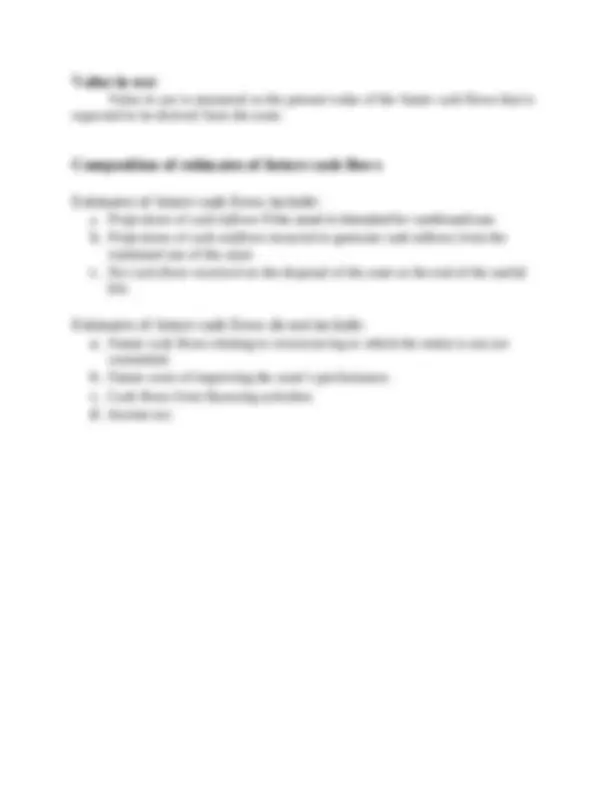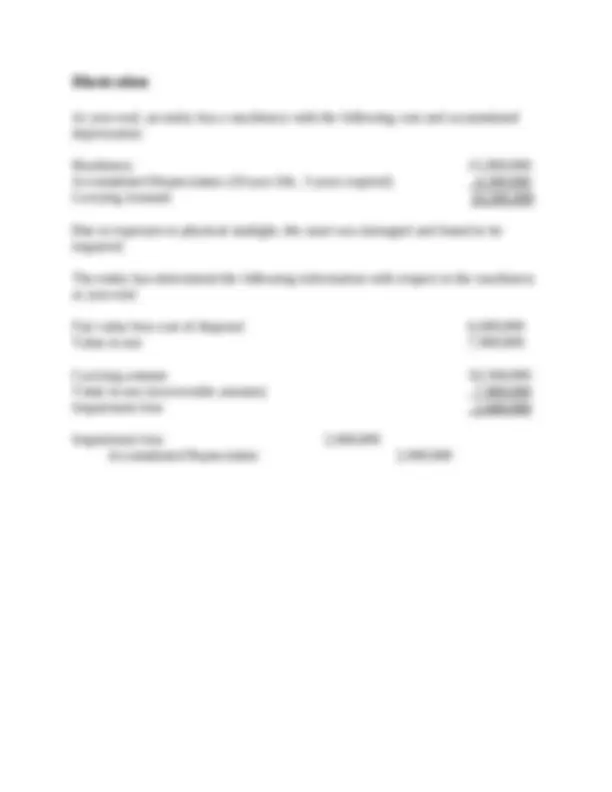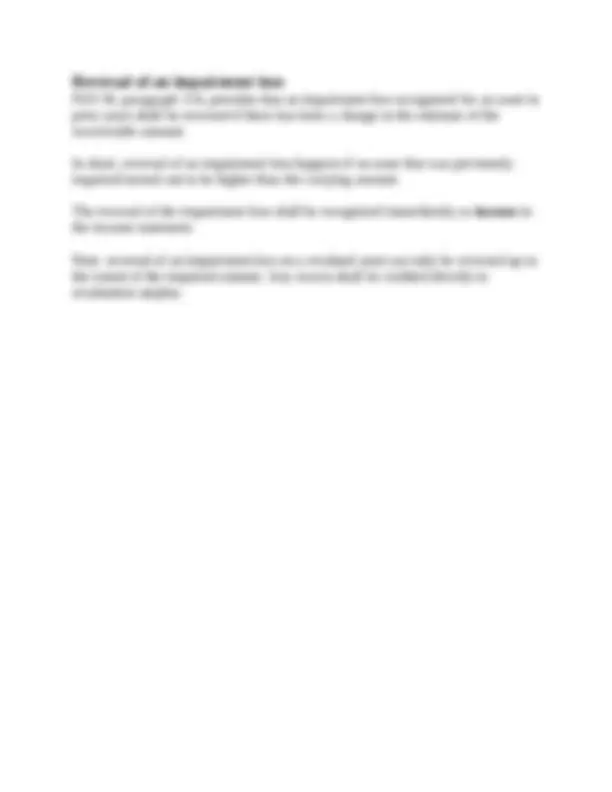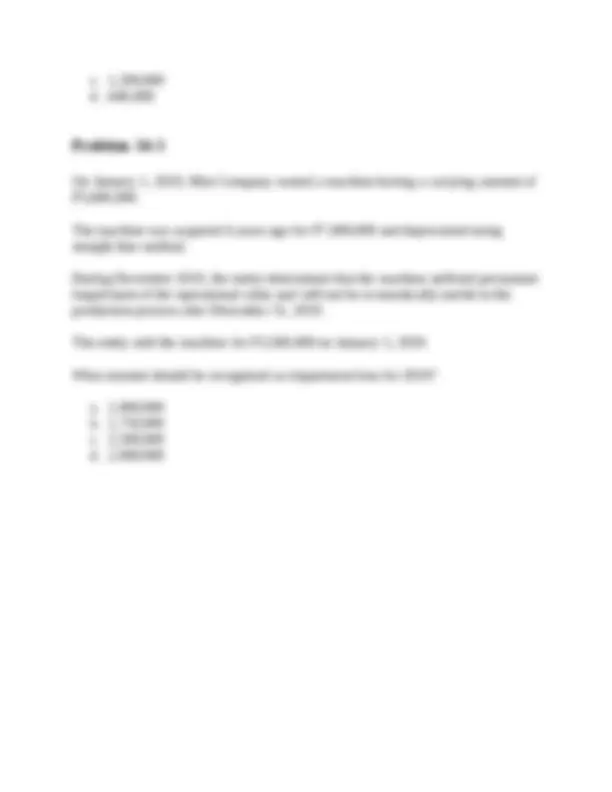






Study with the several resources on Docsity

Earn points by helping other students or get them with a premium plan


Prepare for your exams
Study with the several resources on Docsity

Earn points to download
Earn points by helping other students or get them with a premium plan
Community
Ask the community for help and clear up your study doubts
Discover the best universities in your country according to Docsity users
Free resources
Download our free guides on studying techniques, anxiety management strategies, and thesis advice from Docsity tutors
The impairment of assets, which is the drop of the market value of an asset that the recoverable amount is now noticeably less than the carrying amount recorded in the statement of financial position. It discusses the steps in impairment of an asset, examination of possible impairment, measurement of the recoverable amount, and recognition of the impairment loss. It also covers the reversal of an impairment loss and includes a problem set. useful for accounting students and professionals who want to understand the concept of impairment of assets.
Typology: Lecture notes
1 / 8

This page cannot be seen from the preview
Don't miss anything!





Impairment is the drop of the market value of an asset that the recoverable amount is now noticeably less than the carrying amount recorded in the statement of financial position.
The conservatism principle in the accounting standards recommends an approach that an asset shall not be carried at above the recoverable amount. If the recoverable amount is less than the carrying amount of the asset. The asset is believed to have suffered an impairment loss.
a. Examination of possible impairment b. Measurement of the recoverable amount c. Recognition of the impairment loss
An entity is required to assess the assets for possible impairment at each reporting date. In the case of intangible assets with an indefinite useful life or an intangible asset not yet available for use , annual test for impairment shall be conducted by comparing the carrying amount with the recoverable amount.
The events and circumstances that lead to an asset can be classified as internal and external sources of information.
Physical damage in the asset. Evidence that the economic performance of the asset is worse than projected. Significant change on how the asset is used.
Significant change in the market in which the asset is employed. Significant decrease or decline in the market value of the asset as a result of a competitor entering the same market or just simply the passage of time. The carrying amount of the net asset is more than the fair value or “market capitalization” An increase in the interest rate that affects the discount rate used in calculating the value in use.
After the examination for possible impairment, the next step is to determine the recoverable amount needed to determine the impairment loss.
Recoverable amount can be measure by comparing two variables, fair value less cost of disposal or value in use , whichever is higher.
Fair value is the price that would be received if the asset was decided to be sold to the market participants at the measurement date. Cost of disposal is the additional costs directly attributable to the disposal of an asset. Legal cost, stamp duty and similar transaction tax, cost of removing the asset, and direct cost in bringing the asset into condition for sale are example of cost of disposal.
At year-end, an entity has a machinery with the following cost and accumulated depreciation: Machinery 15,000, Accumulated Depreciation (10-year life, 3 years expired) 4,500, Carrying Amount 10,500, Due to exposure to physical sunlight, the asset was damaged and found to be impaired. The entity has determined the following information with respect to the machinery at year-end: Fair value less cost of disposal 6,600, Value in use 7,900, Carrying amount 10,500, Value in use (recoverable amount) 7,900, Impairment loss 2,600, Impairment loss 2,600, Accumulated Depreciation 2,600,
PAS 36, paragraph 114, provides that an impairment loss recognized for an asset in prior years shall be reversed if there has been a change in the estimate of the recoverable amount. In short, reversal of an impairment loss happens if an asset that was previously impaired turned out to be higher than the carrying amount. The reversal of the impairment loss shall be recognized immediately as income in the income statement. Note: reversal of an impairment loss on a revalued asset can only be reversed up to the extent of the impaired amount. Any excess shall be credited directly to revaluation surplus.
Tekken Company acquired a convenience store building for P5,000,000 on August 31, 2018 The building has a 10-year useful life, a P500,000 salvage value, and was depreciated using the straight-line method. On May 31, 2021, a test for recoverability revealed that the expected net future undiscounted cash inflows related to the continued use and eventual disposal of the building amount to P2,000, The fair value less cost of disposal of the building on May 31, 2021 is P1,900,000 with no residual value. What is the recoverable amount of the building? a. 1,900, b. 1,500, c. 2,000, d. 1,400,
On January 1, 2019, Bourgeoisie Company purchased a machine for P1,500, and has a useful life of 10 years with no residual value. During 2022, after issuing the 2021 financial statements, the entity concluded that the machine suffered permanent impairment of the operational value. The reasonable estimate of the amount expected to be recovered through use of the machine for the period January 1, 2022 through December 31, 2023 is P840,000. What should be reported as carrying amount of the machine on December 31, 2022? a. 720, b. 660,
c. 1,200, d. 640,
On January 1, 2019, Mist Company owned a machine having a carrying amount of P5,600,000. The machine was acquired 4 years ago for P7,000,000 and depreciated using straight line method. During December 2019, the entity determined that the machine suffered permanent impairment of the operational value and will not be economically useful in the production process after December 31, 2019. The entity sold the machine for P3,500,000 on January 5, 2020. What amount should be recognized as impairment loss for 2019? a. 1,900, b. 1,750, c. 3,500, d. 2,000,